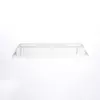Mobile:+86-311-808-126-83
Email:info@ydcastings.com
casting 316 stainless steel
Understanding Casting 316 Stainless Steel Properties, Applications, and Advantages
Casting 316 stainless steel is a vital process in the manufacturing and engineering sectors, combining the inherent strengths of stainless steel with the versatile techniques of casting. This article explores the composition, properties, applications, and advantages of 316 stainless steel, particularly in its cast form.
What is 316 Stainless Steel?
316 stainless steel is part of the austenitic family of stainless steels, which are known for their excellent corrosion resistance, good formability, and high toughness. The composition of 316 stainless steel typically includes iron, carbon, and chromium, along with nickel and molybdenum. The addition of molybdenum is a key characteristic that enhances the steel's resistance to pitting and crevice corrosion, making it suitable for harsh environments.
Casting Process of 316 Stainless Steel
The casting of stainless steel involves pouring molten metal into a mold to create complex shapes and designs that would be difficult to achieve with other forming techniques. In the case of 316 stainless steel, the casting process can be performed using various methods, including sand casting, investment casting, and die casting. Each of these methods has its own unique benefits and is chosen based on the specific requirements of the application.
Properties of Cast 316 Stainless Steel
Cast 316 stainless steel boasts a range of remarkable properties, including
1. Corrosion Resistance Due to its composition, cast 316 stainless steel is highly resistant to corrosive environments, particularly in the presence of chlorides. This makes it ideal for marine and chemical processing applications.
2. Strength and Durability The mechanical properties of cast 316 stainless steel are impressive, offering high tensile strength and impact resistance. This ensures that components made from 316 stainless steel can withstand heavy loads and withstand wear and tear over time.
3. Temperature Resistance Cast 316 stainless steel retains its strength and toughness even at elevated temperatures, making it suitable for high-temperature applications.
4. Weldability One of the significant advantages of 316 stainless steel is its excellent weldability, which allows for easy fabrication and assembly of complex structures.
5. Aesthetic Appeal The smooth finish of cast 316 stainless steel not only provides functional benefits but also gives an attractive appearance, making it a popular choice in architectural applications.
casting 316 stainless steel

Applications of Cast 316 Stainless Steel
The versatile nature of cast 316 stainless steel means it finds applications across a wide variety of industries
- Marine Industry Due to its superior corrosion resistance, cast 316 stainless steel is widely used for boat fittings, propeller shafts, and other components exposed to seawater.
- Chemical Processing In the chemical industry, where corrosive substances are common, cast 316 stainless steel is essential for valves, pumps, and piping systems.
- Food and Beverage The sanitary properties of 316 stainless steel make it suitable for equipment used in food processing, dairy, and pharmaceuticals, where hygiene is a top priority.
- Oil and Gas The oil and gas industry relies on cast 316 stainless steel for offshore applications and equipment, benefiting from its strength and resistance to environmental factors.
Advantages of Using Cast 316 Stainless Steel
The decision to use cast 316 stainless steel comes with several advantages
- Long Lifespan Its resistance to corrosion and wear ensures a longer service life compared to other materials, reducing replacement costs.
- Reduced Maintenance Components made from cast 316 stainless steel require less maintenance, which is particularly beneficial in tough working environments.
- Design Flexibility The casting process allows for intricate designs that can meet specific engineering requirements without sacrificing strength.
Conclusion
In summary, casting 316 stainless steel is an essential process that combines the strengths of a durable material with versatile manufacturing techniques. Its unique properties make it suitable for a range of critical applications across various industries. Whether in marine environments, chemical processing plants, or food production facilities, cast 316 stainless steel continues to be a trusted choice for engineers and manufacturers around the world.
-
Understanding Metal Casting TechniquesNewsApr.02,2025
-
Understanding Exhaust Manifolds for Enhanced Engine PerformanceNewsApr.02,2025
-
The World of Metal FabricationNewsApr.02,2025
-
Key Components for Pump and Turbo EfficiencyNewsApr.02,2025
-
Essential Tools for Automotive Maintenance and RepairNewsApr.02,2025
-
Durable Valve Components for Effective Water ManagementNewsApr.02,2025











